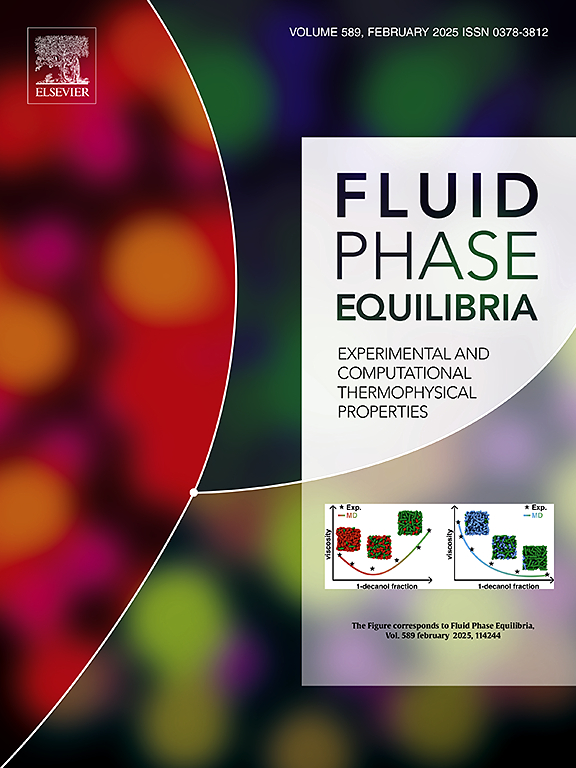PC-SAFT-TS-CAF:纯水和二元水混合物的修正双态模型
IF 2.7
3区 工程技术
Q3 CHEMISTRY, PHYSICAL
引用次数: 0
摘要
水是地球上最丰富的物质之一,但人们仍未完全了解它。50种水的性质表现出具有特征极值的不寻常行为,这表明了两个不同的区域,在那里水要么表现得像简单的流体,要么表现得异常。一种可能的解释是水的双态理论,该理论提出水会形成不同的团簇,一个高密度,一个低密度,在低温下甚至可能形成两种不同的相。在之前的工作中,我们推导了一个框架,通过假设水是处于化学平衡状态的高密度水分子(HDW)和低密度水分子(LDW)的理想溶液,将水的两态理论纳入统计关联流体理论(SAFT),从而重新表述了关联项。我们在摄动链-SAFT (PC-SAFT)的背景下合并了新的关联术语,得到了一个两态SAFT状态方程,PC-SAFT-两态(PC-SAFT- ts)。在这项工作中,我们在之前工作的基础上,通过假设HDW和LDW之间的平衡常数仅与温度有关,并通过拟合HDW和LDW之间特定的交叉关联参数,对PC-SAFT-TS进行了修订。新模型PC-SAFT- ts -交叉关联拟合(CAF)可以预测水的异常特征极值,优于原PC-SAFT模型。用这种新框架研究了二元水混合物(水-碳氢化合物和水-醇),PC-SAFT-TS-CAF设法a)以直接的方式捕获碳氢化合物在水中的最小溶解度,b)在水表现为异常液体的温度范围内改善水-醇汽液和液-液平衡。本文章由计算机程序翻译,如有差异,请以英文原文为准。
PC-SAFT-TS-CAF: a revised two state model for pure water and binary aqueous mixtures
Water is one of the most abundant substances on earth, but it is still not entirely understood. >50 of water’s properties show unusual behavior with characteristic extrema, which indicate two distinct regions, where water either behaves like a simple fluid or has anomalous behavior. A possible explanation is the two-state theory of water, that proposes that water forms different clusters, one with high density and one with low density which may even form two distinct phases at low temperatures.
In a previous work we have derived the framework to incorporate the two-state theory of water in the Statistical-Associating-Fluid-Theory (SAFT), by assuming water is an ideal solution of high-density water molecules (HDW) and low-density water molecules (LDW) which are in chemical equilibrium, thus re-formulating the association term. We have incorporated the new association term in the context of the Perturbed Chain – SAFT (PC-SAFT), arriving to a two-state SAFT Equation of State, PC-SAFT-Two-State (PC-SAFT-TS).
In this work, we are building upon our previous work and revising the PC-SAFT-TS, by assuming the equilibrium constant between HDW and LDW is only temperature dependent and by fitting specific cross-association parameters between HDW and LDW. The new model, PC-SAFT-TS-cross-association-fitted (CAF) can predict the characteristic extrema of water where water shows anomalous behavior and is superior to the original PC-SAFT. Binary aqueous mixtures are studied with this new framework (water-hydrocarbons and water-alcohols) and PC-SAFT-TS-CAF manages to a) capture the solubility minimum of hydrocarbons in water in a straightforward manner and b) improve water-alcohol vapor-liquid and liquid-liquid equilibria at the temperature range where water behaves as an anomalous liquid.
求助全文
通过发布文献求助,成功后即可免费获取论文全文。
去求助
来源期刊

Fluid Phase Equilibria
工程技术-工程:化工
CiteScore
5.30
自引率
15.40%
发文量
223
审稿时长
53 days
期刊介绍:
Fluid Phase Equilibria publishes high-quality papers dealing with experimental, theoretical, and applied research related to equilibrium and transport properties of fluids, solids, and interfaces. Subjects of interest include physical/phase and chemical equilibria; equilibrium and nonequilibrium thermophysical properties; fundamental thermodynamic relations; and stability. The systems central to the journal include pure substances and mixtures of organic and inorganic materials, including polymers, biochemicals, and surfactants with sufficient characterization of composition and purity for the results to be reproduced. Alloys are of interest only when thermodynamic studies are included, purely material studies will not be considered. In all cases, authors are expected to provide physical or chemical interpretations of the results.
Experimental research can include measurements under all conditions of temperature, pressure, and composition, including critical and supercritical. Measurements are to be associated with systems and conditions of fundamental or applied interest, and may not be only a collection of routine data, such as physical property or solubility measurements at limited pressures and temperatures close to ambient, or surfactant studies focussed strictly on micellisation or micelle structure. Papers reporting common data must be accompanied by new physical insights and/or contemporary or new theory or techniques.
 求助内容:
求助内容: 应助结果提醒方式:
应助结果提醒方式:


